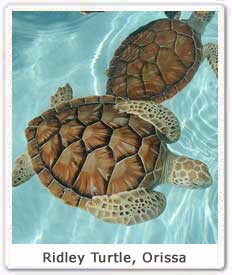 There
is a constant fight going on between the environment and development at
three major nesting sites of Olive Ridley Turtle in Orissa : - The Nasi
Islands in Gahirmatha, the Devi river mouth and the Rushikulya river mouth.
During the month of January to March half of the million turtles nests here.
Single female adult lays around 100- 140 eggs at a time. Every year large
number of these endangered Olives turtle are killed by illegal fishing
trawlers. For the past many centuries they have been haunted for their skin
and meat. Apart from that they become easy prey to the predators like
jackals, dogs, and seagulls etc.
There
is a constant fight going on between the environment and development at
three major nesting sites of Olive Ridley Turtle in Orissa : - The Nasi
Islands in Gahirmatha, the Devi river mouth and the Rushikulya river mouth.
During the month of January to March half of the million turtles nests here.
Single female adult lays around 100- 140 eggs at a time. Every year large
number of these endangered Olives turtle are killed by illegal fishing
trawlers. For the past many centuries they have been haunted for their skin
and meat. Apart from that they become easy prey to the predators like
jackals, dogs, and seagulls etc. The future of these Turtles is obviously in danger as the Indian Ministry of Environment and Forests has allowed two major companies of India – Oil and Natural Gas Cooperation of India (ONGC) and Reliance Industries (RIL) to carry out the off shore drilling off the coast of Orissa. The proposal has been alloted to drill 20 exploratory wells in the area.
ONGC has been alloted two blocks. One of them is located around the Chilka Lake, which is the largest Brackish water lagoon in Asia. Oil spill would cause disturbance to the lake fragile habitat, which is the home to rare Irrawady Dolphin and 1 million migratory waterfowl. Than the plans to construct the new steel and ore port at Dharma, which lies less than 15 km distance from the Gahimatha Marine Sanctuary is a matter of serious concern. Pollution and artificial lights from the giant port would be the greatest threat to the nesting turtles. If constructed, it will be largest port in South Asia. The port is the joint venture between the Tata Steel and Larsen and Toubro. Than it is the question of livelihood of thousands of fisherman in the area.
In order to protect the Olive Ridley turtle, the Gahirmatha coast has been assigned as the Marine Sanctuary. In 2003 WWF launched a campaign in the Rushikulya nesting site for the protections of their nests and the hatchlings. The Government of Orissa is planning to declare Rushikulya rookery as the protected area. Than Green Peace India (NGO), has launched many campaigns to protect the Olive Ridley Turtle and its nesting site. On the other hand Indian Oil Cooperation has alloted 10 million rupees to the Orissa forest department for the protection of the turtles. Oilve Ridley turtle are protected under the Wildlife Protection Act (1972), and its killing or threatening could lead to two years to seven years of imprisonment. It is also protected under Cities International Conservation agreement (CICA).






